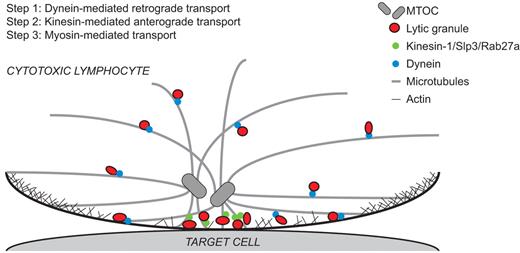Lymphocyte cytotoxicity is essential in immune defense. In this issue of Blood, Kurowska and colleagues define a Rab27a/Slp3/kinesin-1 complex that facilitates anterograde microtubule transport of lytic granules, representing a critical step in lymphocyte granule exocytosis and cytotoxicity.1
Cytotoxic lymphocytes, encompassing cytotoxic T lymphocytes (CTLs) and natural killer (NK) cells, kill pathogen-infected neoplastic as well as certain activated hematopoietic cells through targeted release of perforin-containing lytic granules. Autosomal recessive mutations in several proteins required for cytotoxic lymphocyte granule exocytosis have been associated with fatal diseases.2 The small GTPase Rab27a is one such protein. Rab27a-deficient patients typically present with hyperinflammatory hemophagocytic syndromes due to defects in lytic granule exocytosis, and also display partial albinism owing to a role for Rab27a in the trafficking and secretion of pigment granules from melanocytes.3
Tug-of-war for cytotoxicity: lytic granule movement at cytotoxic lymphocyte immune synapses. First, engagement of activating receptors induces dynein-dependent retrograde transport of lytic granules on microtubles toward the MTOC, followed by movement of the MTOC with clustered granules to the immune synapse. Second, a novel kinesin-1/Slp3/Rab27a complex mediates anterograde transport of lytic granules away from the MTOC and toward the plasma membrane, before final myosin-dependent exocytosis of granules at the immune synapse.
Tug-of-war for cytotoxicity: lytic granule movement at cytotoxic lymphocyte immune synapses. First, engagement of activating receptors induces dynein-dependent retrograde transport of lytic granules on microtubles toward the MTOC, followed by movement of the MTOC with clustered granules to the immune synapse. Second, a novel kinesin-1/Slp3/Rab27a complex mediates anterograde transport of lytic granules away from the MTOC and toward the plasma membrane, before final myosin-dependent exocytosis of granules at the immune synapse.
On target cell recognition by cytotoxic lymphocytes, the prevailing view is that lytic granules first undergo retrograde transport along microtubules to the microtubule organizing center (MTOC).4 Such minus end–directed transport is mediated by the motor protein dynein. Once clustered at the MTOC, granules are then moved toward the interface formed with the target cell, an area termed the immune synapse. This is then followed by a final stage of myosin IIA–dependent movement on actin, facilitating plasma membrane fusion.5 However, almost 20 years ago, Burkhardt and colleagues demonstrated that when lytic granules were isolated and allowed to interact with microtubules in the presence of motor protein–containing supernatants in vitro, movement was strongly biased toward anterograde transport.6 Such anterograde transport was inhibited by antibody-mediated depletion of kinesin. Conventional kinesins, as opposed to dyneins, are motor proteins that mediate anterograde transport of cargo along microtubules and consist of a heterotetramer of 2 heavy chains with motor activity bound to 2 light chains. A role for kinesins and anterograde transport of lytic granules in lymphocyte cytotoxicty has not been investigated.
Prompted by findings in neurons, where Rab27b forms a complex with the synaptotagmin- like protein (Slp)–1 as well as kinesin-1 to facilitate anterograde transport of vesicles,7 Kurowska et al examined the expression of Slps and kinesin subunits in human CTLs.1 At the transcript level, they established that Slp1 and Slp3 represent the major Slp isoforms in CTLs, and that the KIF5B heavy chain and KLC1 light chain are the predominant kinesin-1 subunits. Rab27a can bind multiple effectors, including Slp1, Slp2a, Slp3, Slac2a, and Slac2b.8 Coimmunoprecipitation experiments revealed that KLC1 interacts with Slp3. The interaction was mapped to a linker region on Slp3 that binds the C-terminal tetratricopeptide repeat (TRP) domain of KLC1. Importantly, involvement of kinesin-1 in lymphocyte cytotoxicity was established through the impairment of granule exocytosis on transfection of a KIF5B dominant-negative construct, knockdown of KIF5B using siRNA, and overexpression of the cognate Slp3 linker region. Notably, none of these manipulations impaired granule polarization to the immune synapse. Together, these data reveal that the Rab27a/Slp3/kinesin-1 complex is required for final movement of lytic granules at the immune synapse for exocytosis. Consistent with these data, live cell imaging revealed that lytic granule movement at the plasma membrane is both microtubule- and actin-dependent, whereas movement in the cytoplasm is only dependent on microtubules.9 In this setting, Rab27a-deficiency resulted in a reduced fraction and less mobility of lytic granules at the plasma membrane, concomitant with increased mobility of lytic granules in the cytosol.
Interestingly, Slp1 and Slp2a are also expressed in CTLs and have been implicated in lytic granule exocytosis.10 Kurowska and colleagues found that overexpression of either Slp1 or Slp3 inhibited lytic granule exocytosis, whereas co-overexpression of Rab27a restored exocytosis in the context of Slp3, but not Slp1. This suggests distinct regulation of lytic granule secretion by different Rab27a-Slp complexes. Thus, sequential interactions of different Slp effectors may intricately regulate lytic granule trafficking and exocytosis at the plasma membrane. Further work is required to clarify these issues as well as how granules are transferred to actin filaments.
The findings by Kurowska and coworkers provide further insights into the intriguing biology of lymphocyte cytotoxicity. After dynein-dependent retrograde microtubule transport of granules to the MTOC and movement of the MTOC to the immune synapse, they propose a switch to kinesin-1–dependent anterograde microtubule transport to position granules near the plasma membrane (see figure), before final myosin IIA–driven movement on actin for plasma membrane fusion. The Rab27a/Slp3/kinesin-1 complex is clearly a critical facilitator of lymphocyte cytotoxicity, as Rab27a deficiency abrogates granule exocytosis, causing immunodeficiency. Notably, the pattern of granule exocytosis at cytotoxic lymphocyte immune synapses may depend on the nature of receptors engaged,11 suggesting different modes of spatio-temporal regulation of lytic granule trafficking and fusion by distinct receptors. Thus, further experiments are needed to address how dynein and kinesin motor proteins are recruited to regulate the tug-of-war facilitating granule movement along microtubules.
In conclusion, a critical molecular complex for cytotoxic lymphocyte granule movement and exocytosis has been identified. Besides Rab27a, mutations in the gene encoding Slp3, SYTL3, could be associated with immunodeficiencies. Further work will hopefully address how different motor proteins for lymphocyte cytotoxicity are regulated spatially and temporally.
Conflict-of-interest disclosure: The authors declare no competing financial interests. ■


This feature is available to Subscribers Only
Sign In or Create an Account Close Modal